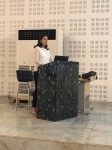The June 2, 2019

Key words: Diatoms, lipids, fatty acids, PUA, light
Abstract
Diatoms (Bacillariophyta) are photosynthetic unicellular organisms with silica cell walls that constitute important primary producers in aquatic environments and have great potential in biotechnologies. In Algeria, only few studies were made on diatoms. In this work we isolated diatoms from the coastal water of Oran and an oasis in Tamanrasset, and we also worked on two strains of Haslea ostrearia from the Nantes Culture Collection.
Isolated diatoms were cultivated under controlled conditions and identified using a combination of scanning electron microscopy and molecular barcoding as Nitzschia aurariae, Entomoneis sp., Cylindrotheca closterium and Skeletonema pseudocostatum for Oran and Thalassiosira pseudonana, Fistulifera sp., Navicula sp., Nitzschia sp. and Tryblionella sp. for Tamanrasset. For the strains of Oran and the two strains of H. ostrearia, growth rates, lipid content and fatty acids composition were compared when cultivated under 3 different light intensities (50, 125 and 230 µmol photons m-2 s-1) at constant 14:10 L.D photoperiod. Results showed that for N. aurariae, Entomoneis sp., C. closterium optimum growth was achieved under 50 µmol photons m-2 s-1 while it was 230 µmol photons m-2 s-1 for S. pseudocostatum and H. ostrearia. Lipid production was higher at 50 µmol photons m-2 s-1 for N. aurariae and at 230 µmol photons m-2 s-1 for H. ostrearia (NCC- 495), S. pseudocostatum and Entomoneis sp. For H. ostrearia NCC- 484, the higher production was observed under 125 µmol photons m-2 s-1.
Regarding fatty acids composition, the most produced were C16:0, C16:1 and C20:5 whatever the species considered. The composition of the main class of proteins, lipids, carbohydrates depending on culture conditions was studied by Fourier Transformed Infra Red spectroscopy and identified by means of vibrational spectroscopy. Also all three species from Oran demonstrated the ability to produce polyunsaturated aldehydes (PUA): N. aurariae produced Heptadienal andDecadienal, Entomoneis sp. produced Heptadienal and Octadienal while C. closterium produced Heptadiénal and Decadienal. Finally, the complete chloroplast genome of S. pseudocostatum was obtained by next generation sequencing, annotated and described.
Jury members
